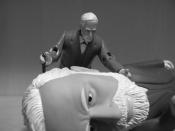Summary-Freud
Theory:
The basis of Freud's theory was the conscious mind, the preconscious mind, and the unconscious mind. His study had much to do with many aspects of the conscious and unconscious states; however, the major divisions included the conscious, preconscious, and the unconscious. The conscious and the preconscious are the smallest part of this theory, as well as the easiest to understand. The conscious is what you are aware of at any particular moment, in present perceptions, memories, and thoughts. The conscious is the most influential part of personality; it represents the "here and now."
The preconscious is what was considered "available memory"; anything that can easily be made conscious; it includes both conscious and unconscious material. Preconscious has been known as "the buffer zone between conscious and unconscious realms." In other words, the preconscious includes all those memories that you are not thinking of now, but can readily bring to mind easily.
The unconscious is the largest part of this theory and more difficult to understand. The unconscious includes all the things that are not easily available to one's awareness. The unconscious thoughts are not organized and not logical. This may include many things that have their origins there, such as our drives or instincts, as well as things that are put there because we cannot bear to remember them, such as the memories and emotions associated with trauma. Freud feels that the unconscious is the source of our motivations in life, such as food, sex, neurotic compulsions, or motives toward a career, and the conscious is where we make our decisions to deny or resist these motives. Every desire, every motive, everything that is within us is formed from the unconscious.
Within these stages of consciousness, there is repression, which is the state in which...


